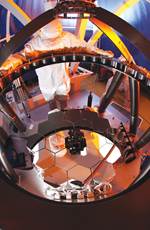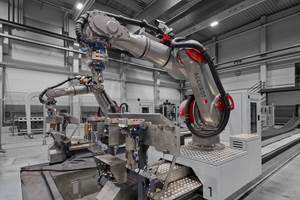James Webb Space Telescope primary mirror fully assembled
The mirror consists of 18 primary mirror segments, each 1.3m wide and mounted on a composite backplane structure. The telescope will be launched in 2018.
NASA reports that the 18th and final primary mirror segment is installed on what will be the biggest and most powerful space telescope ever launched. The final mirror installation at NASA’s Goddard Space Flight Center in Greenbelt, MD, US, marks an important milestone in the assembly of the agency’s James Webb Space Telescope.
Using a robotic arm reminiscent, the team meticulously installed all of Webb's primary mirror segments onto the composite telescope structure. Each of the hexagonal-shaped mirror segments measures just over 4.2 ft/1.3m across — about the size of a coffee table — and weighs approximately 88 lb/40 kg. Once in space and fully deployed, the 18 primary mirror segments will work together as one large 21.3-ft/6.5m diameter mirror.
“Scientists and engineers have been working tirelessly to install these incredible, nearly perfect mirrors that will focus light from previously hidden realms of planetary atmospheres, star forming regions and the very beginnings of the Universe,” says John Grunsfeld, associate administrator for NASA’s Science Mission Directorate in Washington. “With the mirrors finally complete, we are one step closer to the audacious observations that will unravel the mysteries of the Universe.”
"Completing the assembly of the primary mirror is a very significant milestone and the culmination of over a decade of design, manufacturing, testing and now assembly of the primary mirror system," says Lee Feinberg, optical telescope element manager at Goddard. "There is a huge team across the country who contributed to this achievement."
While the primary mirror installation may be finished on the tennis court-sized infrared observatory, there still is much work to be done.
"Now that the mirror is complete, we look forward to installing the other optics and conducting tests on all the components to make sure the telescope can withstand a rocket launch," says Bill Ochs, James Webb Space Telescope project manager. "This is a great way to start 2016!"
The mirrors were built by Ball Aerospace & Technologies Corp., in Boulder, CO, US. Ball is the principal subcontractor to Northrop Grumman for the optical technology and optical system design. The installation of the mirrors onto the telescope structure is performed by Harris Corp., a subcontractor to Northrop Grumman. Harris Corp. leads integration and testing for the telescope.
“The Harris team will be installing the aft optics assembly and the secondary mirror in order to finish the actual telescope,” says Gary Matthews, director of Universe Exploration at Harris Corp. “The heart of the telescope, the Integrated Science Instrument Module, will then be integrated into the telescope. After acoustic, vibration and other tests at Goddard, we will ship the system down to Johnson Space Center in Houston for an intensive cryogenic optical test to ensure everything is working properly.”
The James Webb Space Telescope is the scientific successor to NASA's Hubble Space Telescope. It will be the most powerful space telescope ever built. Webb will study many phases in the history of our universe, including the formation of solar systems capable of supporting life on planets similar to Earth, as well as the evolution of our own solar system. It’s targeted to launch from French Guiana aboard an Ariane 5 rocket in 2018. Webb is an international project led by NASA with its partners, ESA (European Space Agency) and the Canadian Space Agency.
Related Content
MFFD longitudinal seams welded, world's largest CFRTP fuselage successfully completed
Fraunhofer IFAM and partners have completed left and right welds connecting the upper and lower fuselage halves and sent the 8×4-meter full-scale section to ZAL for integration with a cabin crown module and testing.
Read MoreAutomated robotic NDT enhances capabilities for composites
Kineco Kaman Composites India uses a bespoke Fill Accubot ultrasonic testing system to boost inspection efficiency and productivity.
Read MoreDevelopment of a composite liquid hydrogen tank for commercial aircraft
Netherlands consortium advances cryogenic composites testing, tank designs and manufacturing including AFP, hybrid winding, welding of tank components and integrated SHM and H2 sensors for demonstrators in 2025.
Read MorePlant tour: Aernnova Composites, Toledo and Illescas, Spain
RTM and ATL/AFP high-rate production sites feature this composites and engineering leader’s continued push for excellence and innovation for future airframes.
Read MoreRead Next
Composites stabilize space-based telescope
Composite Primary Mirror Backplane Support Structure to hold James Webb Space Telescope’s thermal stability within extremely tight 38-nm dimensional tolerance.
Read MoreNext-gen fan blades: Hybrid twin RTM, printed sensors, laser shock disassembly
MORPHO project demonstrates blade with 20% faster RTM cure cycle, uses AI-based monitoring for improved maintenance/life cycle management and proves laser shock disassembly for recycling.
Read MoreScaling up, optimizing the flax fiber composite camper
Greenlander’s Sherpa RV cab, which is largely constructed from flax fiber/bio-epoxy sandwich panels, nears commercial production readiness and next-generation scale-up.
Read More


























